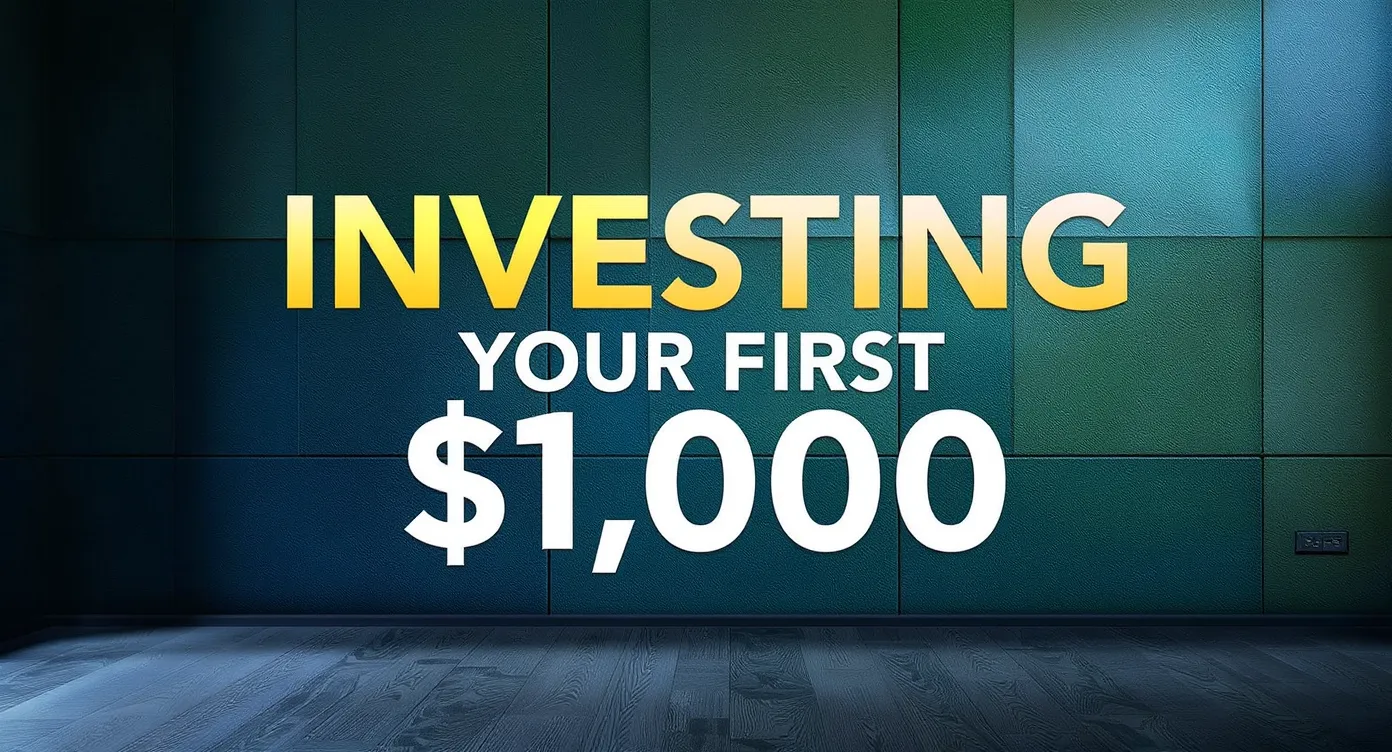You've earned your first thousand dollars. Maybe it's from a side hustle, a bonus, freelance work, or simply disciplined saving. Now comes the critical question: What do you do with it?
Most people squander this opportunity. They spend it. They let it sit in a low-interest savings account losing to inflation. Or they make impulsive investment decisions that cost them money.
The people who build wealth make this money work intentionally. They understand that the first $1,000 is the hardest to save, but it's also the most important—because it's the foundation that compounds into $10,000, then $100,000, then real wealth.
This guide walks you through exactly how to deploy your first $1,000, whether you're starting from debt, living paycheck-to-paycheck, or genuinely ready to invest.
Part 1: Assess Your Starting Position
Before investing a single dollar, understand where you stand financially. The right move depends on your situation.
Situation 1: You Have High-Interest Debt
If you carry credit card debt (18%+ interest), student loans (6%+), or car loans (5%+), your "return" on paying down debt is guaranteed.
The Rule: If your debt interest rate exceeds 7%, paying down debt beats investing.
Situation 2: You Have No Emergency Fund
An emergency fund is non-negotiable. Without it, one car repair or medical bill forces you back into debt. Your target should be 3-6 months of living expenses. For your first $1,000, put it entirely into a high-yield savings account (HYSA).
Situation 3: You Have Debt AND No Emergency Fund
This is common. Prioritize strategically. A good allocation is $400 toward your emergency fund (HYSA) and $600 toward high-interest debt payoff.
Situation 4: You Have Debt (Low-Interest) AND Emergency Fund
You can afford to invest while paying it down. Consider $500 toward continuing debt payments (beyond minimum) and $500 toward investing.
Situation 5: Debt-Free With Emergency Fund
Congratulations—you're in the ideal position. Invest your entire $1,000.
Part 2: High-Yield Savings Accounts for Your Emergency Fund
If you're building an emergency fund, don't park money in traditional savings accounts earning 0.01% APY. Modern high-yield savings accounts (HYSAs) offer 4-5% APY with no risk.
Why HYSA for Emergency Funds
- Safety: FDIC insured up to $250,000. Your money is completely safe.
- Liquidity: Access funds immediately without penalties.
- Returns: $1,000 earning 4.5% generates $45/year passively.
- Simplicity: No stock market risk. No complexity.
Part 3: Understanding Investment Basics
Before deploying money into investments, understand what you're actually buying: Stocks (ownership in companies), Bonds (loans to companies/governments), and Index Funds (baskets of stocks that track the market).
Risk vs. Return
The fundamental trade-off in investing is that higher returns require taking on higher risk. The S&P 500 (500 largest US companies) has averaged ~10% annual returns over 90+ years. This is the baseline for "market returns."
Time Horizon Matters
Your time horizon determines appropriate risk. If you need the money in 5 years or less, keep it in HYSAs or bonds. If your time horizon is 10+ years, you can be aggressive (80-100% stocks) because you have time to recover from downturns.

Part 4: Where to Invest Your First $1,000
Option 1: Index Funds (Best for Beginners)
Index funds are the simplest, lowest-cost way to invest. You buy a fund tracking the S&P 500 (or total market). The fund holds shares in 500+ companies. Examples include Vanguard S&P 500 ETF (VOO) or Fidelity S&P 500 Index Fund (FSKAX). You can buy partial shares for as little as $1.
Recommendation: If you're investing your first $1,000, put it in a total market index fund like VTSAX (Vanguard) or FSKAX (Fidelity).
Option 2: Target-Date Funds
These funds automatically adjust risk based on your target retirement year (e.g., "2060 Target-Date Fund"). The fund starts aggressive (mostly stocks) and gradually becomes conservative (more bonds) as you approach retirement. Excellent for a "set it and forget it" approach.
Option 3: Individual Stocks
Buying individual company shares is exciting but risky for beginners. It requires research, and emotional decision-making often leads to losses. Don't put your first $1,000 here. Learn with index funds first.
Part 5: Opening Your First Investment Account
You need a brokerage to buy investments. For beginners: Fidelity, Vanguard, and Charles Schwab are all excellent choices with zero account minimums and great reputations.
Account Types
- Taxable Brokerage Account: No contribution limits, but you pay taxes on gains annually.
- Roth IRA: Best for most beginners. You contribute after-tax money ($7,000 limit in 2025), and your investments grow completely tax-free for retirement.
- Traditional IRA: You may get a tax deduction on contributions now, but you pay taxes on withdrawals in retirement.
- 401(k): Offered through an employer. Prioritize this if your employer offers a "match" (that's free money).
Recommendation for Your First $1,000: If you have a 401(k) with an employer match, put it there. Otherwise, open a Roth IRA.
First Investment Action Plan
- Open a Roth IRA with Fidelity or Vanguard.
- Fund the account with your $1,000.
- Purchase a total market index fund (like VTSAX or FSKAX).
- Done. You've invested. Now wait.
Part 6: The Psychology of Investing
Most beginners lose money not because their investments are bad, but because they make emotional decisions.
Common Emotional Mistakes
- Panic Selling: The market drops, you panic and sell everything at a loss.
- FOMO (Fear of Missing Out): A stock jumps 50%, you chase it at the peak, then lose money when it corrects.
- Overtrading: You constantly buy and sell, paying fees and taxes, and underperforming the market.
How to Overcome Emotions
Rule 1: Automate Everything. Set up automatic monthly investments. This creates dollar-cost averaging (buying consistent amounts regardless of price).
Rule 2: Ignore Short-Term Noise. The market will drop. This is normal. These are opportunities to buy more, not reasons to sell.
Rule 3: Don't Check Too Frequently. Check your portfolio quarterly or annually, not daily. Frequent checking increases emotional reactions.
Part 7: Diversification Beyond Stocks
Your first $1,000 in a total market index fund is perfectly diversified. As you invest more ($5,000-$10,000+), you can consider adding bonds or real estate index funds (REITs) to balance your risk, but it's not necessary at the very beginning.

-- Sponsored Content --
Part 8: Protecting Your Investments: Financial Security Essentials
As you begin investing and accumulating wealth, protecting your accounts becomes critical. Your investment accounts are prime targets for cybercriminals, especially when accessed on public WiFi or untrusted networks.
Protecting Your Investment Accounts
- Use strong, unique passwords for each financial account.
- Enable Two-Factor Authentication (2FA) on your brokerage account.
- Avoid accessing investment accounts on public WiFi (coffee shops, airports, hotels).
- Use a VPN on any untrusted network to encrypt your connection.
Surfshark: Protecting Your Financial Data
When you begin accessing investment accounts from various locations, you need reliable encryption protecting your financial data. Surfshark is an affordable, reliable VPN service perfect for investors and anyone managing financial accounts online.
Why Surfshark for Financial Security
A VPN (Virtual Private Network) encrypts your internet traffic, protecting your data even on public WiFi. This is essential when traveling or working remotely.
- Military-Grade Encryption: Uses AES-256 encryption (the same standard used by governments) to protect all data transmitted through your connection.
- No-Logs Policy: Surfshark doesn't log your browsing activity. Your investment account logins and financial transactions remain private.
- Unlimited Simultaneous Connections: Protect your phone, laptop, and tablet simultaneously.
- Kill Switch: If your VPN connection drops, Surfshark's kill switch blocks all internet traffic, preventing unencrypted data transmission.
- Affordable: Surfshark costs $1.99-4.29/month on long-term plans.
Real Scenarios Where Surfshark Protects You
Scenario 1: You're traveling and want to check your brokerage account at the airport. Without a VPN, you're vulnerable on the airport WiFi. With Surfshark, your login credentials are encrypted.
Scenario 2: You're a remote worker managing your 401(k) from various coffee shops. Surfshark ensures that regardless of location, your financial data is protected.
Protect Your Growing WealthYour financial accounts are a target. Encrypt your connection and protect your investments from hackers on public WiFi with Surfshark VPN.
Get Surfshark (80% Off + 3 Mos. Extra)

Part 9: Common Investing Mistakes to Avoid
Mistake 1: Trying to Time the Market
Beginners think they can predict market peaks and troughs. They can't. Missing just the 10 best days in the market over 20 years cuts returns by 50%. The Fix: Invest consistently (dollar-cost averaging) through market cycles.
Mistake 2: Chasing Past Performance
A fund returned 30% last year. You buy it. This year it returns -5%. The Fix: Focus on low-cost index funds with consistent, moderate returns. Boring beats exciting.
Mistake 3: Paying High Fees
Some advisors charge 1-2% annually in fees. Over 30 years, high fees can reduce your returns by 30-50%. The Fix: Use zero-commission brokerages and buy index funds with expense ratios under 0.20%.
Mistake 4: Investing Money You'll Need Soon
You invest $5,000 planning to buy a house in 2 years. The market crashes. You're forced to sell at a loss. The Fix: Don't invest money you'll need within 5+ years. Use HYSAs for shorter timelines.
Part 10: Your Investment Timeline
The difference between wealthy people and everyone else isn't intelligence or luck. It's the willingness to start small and be consistent.
Your first $1,000 seems insignificant. But add consistent investing every month for 10 years, and you could have $100,000+. The math is simple. The challenge is emotional discipline and consistency.
Your Action Plan:
- Assess your position: Emergency fund? Debt?
- Choose your account: Roth IRA at Fidelity or Vanguard.
- Fund it: Your $1,00Services.
- Invest: Buy a total market index fund.
- Automate: Set up monthly automatic investments.
- Protect: Use a VPN when accessing accounts on public networks.
- Wait: Check quarterly, not daily. Ignore market noise.
In 10 years, you'll look back amazed at how that first $1,000 decision changed your financial life. The time to start is now.
Ready to Experience the Future of Surveys?
Now that you understand how AI is improving surveys, find platforms that leverage this technology to offer better experiences and rewards.
Explore Top Survey Platforms